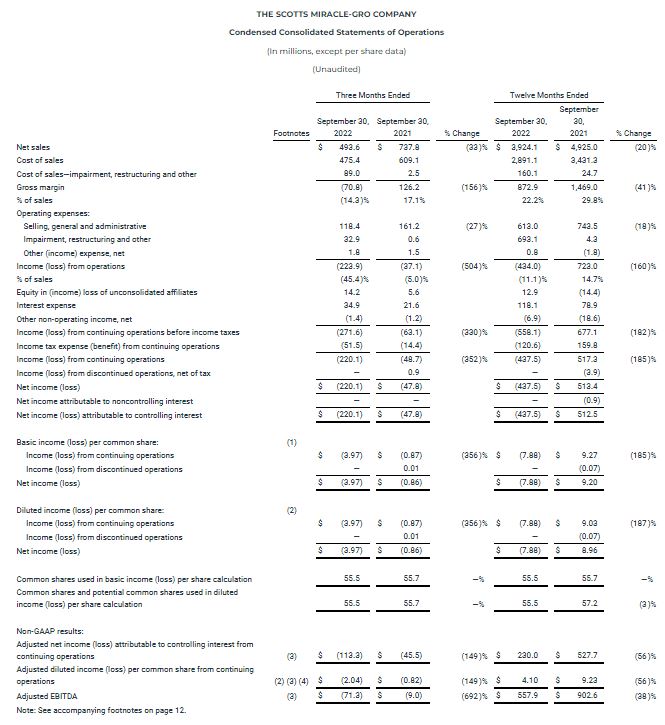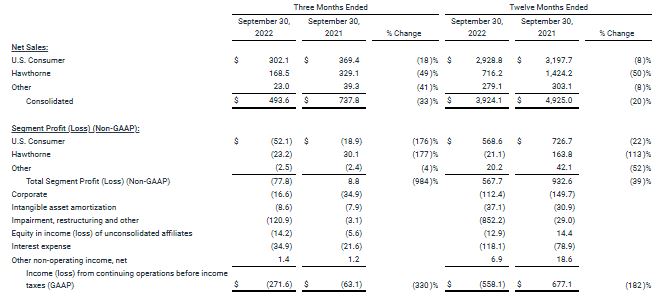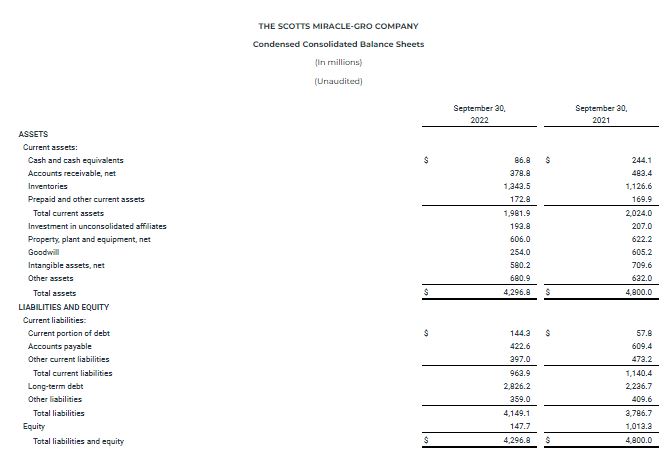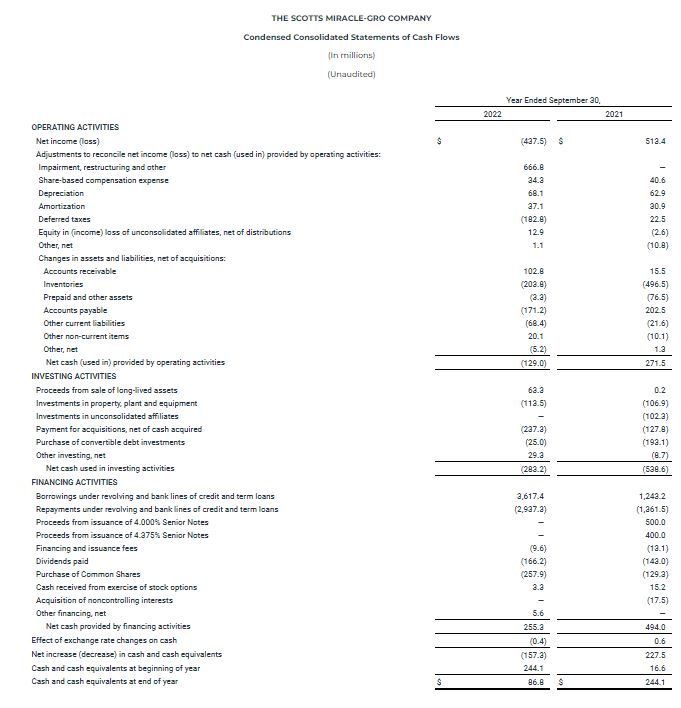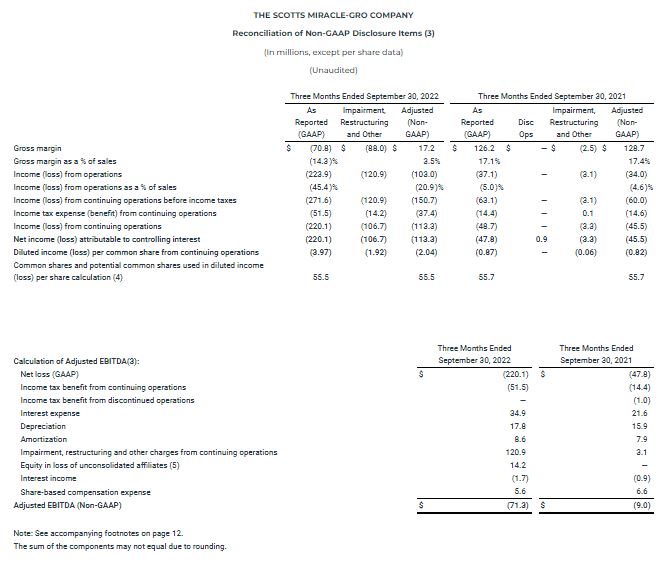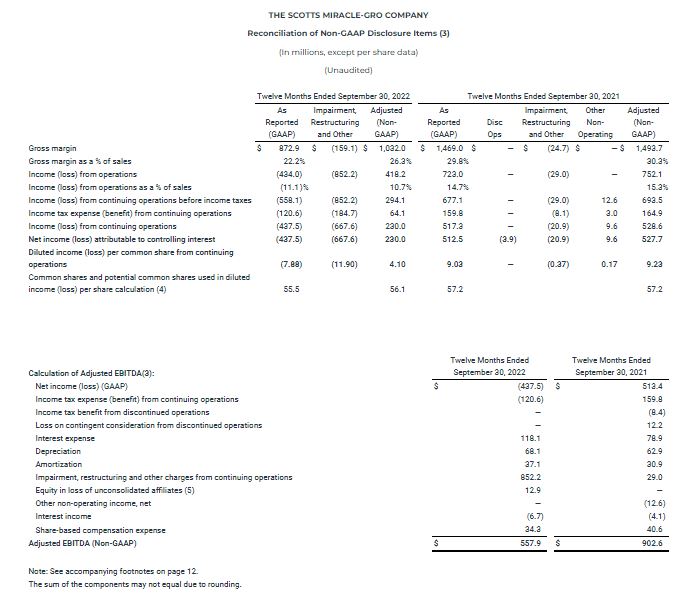![]()
ScottsMiracle-Gro Announces Full-Year Sales and Earnings in Line with Guidance; Launches Phase Two of Project Springboard to Realize Further Cost Savings
- Company meets FY 2022 EPS, free cash flow guidance
- Project Springboard achieves $100 million of annualized cost savings, introduces additional target of $85 million in savings
- Company reaffirms projection of $1 billion in free cash flow over next two years
MARYSVILLE, Ohio, Nov. 02, 2022 (GLOBE NEWSWIRE) — The Scotts Miracle-Gro Company (NYSE: SMG), the world’s leading marketer of branded consumer lawn and garden as well as indoor and hydroponic growing products, today announced its results for the fourth quarter ended September 30, 2022.
Our leadership team and associates successfully managed the challenging finish to fiscal 2022 to deliver consolidated sales and earnings results consistent with our expectations.
 Jim Hagedorn, chairman and CEO
Jim Hagedorn, chairman and CEO
While we were disappointed with our overall financial performance for the year, we remained within our leverage covenants and established a path forward to return the Company to acceptable levels of profitability.
“As we look to the year ahead, we are committed to further improving our operating and financial performance by capitalizing on the strengths of the U.S. Consumer business and right-sizing Hawthorne for the realities of today. We will prioritize more profitable product mixes along with front-loading our marketing and promotional activities to drive early consumer traffic in close coordination with our retailer partners. At the same time, we are taking decisive actions across the organization with the goal of effectively managing leverage and creating stronger conditions for the long-term success of our business.”
Fourth Quarter Results Highlights
Sales for the period declined by 33 percent, reflecting decreases in both major business segments. The Company reported a GAAP loss of $3.97 per share, which includes pre-tax impairment and restructuring charges of $120.9 million. Non-GAAP adjusted earnings per share, which is the basis of the Company’s guidance, was a loss of $2.04.
Project Springboard 2.0 – Additional $85 Million of Cost Reductions Planned
On August 3, 2022, the Company announced its cross-functional Project Springboard initiative to expand margins, improve free cash flow and strengthen the balance sheet. The first phase of this initiative achieved $100 million of annualized savings split between fiscal 2022 and fiscal 2023, primarily realized in headcount and variable SG&A reductions.
The Company has launched the second phase of this initiative, Project Springboard 2.0, targeting an additional $85 million of cost reductions to be realized in fiscal 2023 and fiscal 2024. Expected savings will be driven by:
- Reducing the operating footprint in the Hawthorne and U.S. Consumer segments by closing points of distribution
- Further right-sizing of overhead expenses in Hawthorne enabled by integration into ScottsMiracle-Gro
- Enhancing profitability driven by improved product mix and fewer SKUs in the Hawthorne segment
- Executing on Supply Chain labor and materials efficiencies
- Improving productivity of trade programs
- Further reductions in corporate SG&A spending
“The operating cost savings identified by Project Springboard 2.0 give us momentum toward our targeted debt-to-EBITDA leverage ratio in the 4’s by the end of fiscal 2023,” said Dave Evans, interim chief financial officer. “We will continue to have high levels of financial discipline to ensure we maintain appropriate financial headroom under our lending agreements.”
Financial Results
Fourth Quarter Details
For the quarter ended September 30, 2022, company-wide sales decreased 33 percent, to $493.6 million. U.S. Consumer segment sales declined 18 percent, to $302.1 million, from $369.4 million. Hawthorne segment sales decreased 49 percent, to $168.5 million, compared with $329.1 million during the same period last year.
GAAP and non-GAAP adjusted gross margin rates for the quarter were negative 14.3 percent and positive 3.5 percent, respectively. These compare to 17.1 percent and 17.4 percent, respectively, in the prior year. The declines were due primarily to unfavorable fixed cost leverage related to volume. Higher commodity costs and unfavorable distribution costs also negatively impacted gross margins in the quarter. Those pressures were partially offset by price increases and favorable segment mix due to the decline in the lower-margin Hawthorne segment.
SG&A decreased 27 percent, to $118.4 million, due to lower accruals for annual incentive compensation and cost-reduction efforts.
Interest expense increased $13.3 million on a year-over-year basis to $34.9 million, driven by an increase in average borrowings. The Company’s debt-to-EBITDA ratio at the end of the quarter was 6.0 times.
The Company reported a loss from continuing operations of $220.1 million, or $3.97 per share, compared with a prior year loss of $48.7 million, or a loss of $0.87 per share. The non-GAAP adjusted loss in the quarter, which excluded impairment, restructuring and other non-recurring items, was $113.3 million, or $2.04 per share, compared with a loss of $45.5 million, or $0.82 per share in 2021.
Fiscal 2022 Details
Company-wide sales on a full-year basis decreased 20 percent, to $3.92 billion, compared with $4.93 billion a year ago. Sales in the U.S. Consumer segment decreased 8 percent, to $2.93 billion. Hawthorne sales decreased 50 percent to $716.2 million.
 The GAAP gross margin rate on a year-to-date basis was 22.2 percent. The non-GAAP adjusted rate was 26.3 percent. These compare with 29.8 percent and 30.3 percent, respectively, last year. The reasons for the full-year decline are consistent with the factors that drove fourth-quarter results.
The GAAP gross margin rate on a year-to-date basis was 22.2 percent. The non-GAAP adjusted rate was 26.3 percent. These compare with 29.8 percent and 30.3 percent, respectively, last year. The reasons for the full-year decline are consistent with the factors that drove fourth-quarter results.
SG&A was $613 million, an 18 percent decrease from 2021, driven by lower accruals for annual incentive compensation and cost-reduction efforts.
Interest expense increased $39.2 million, to $118.1 million, due to an increase in average borrowings.
The Company reported a full year loss from continuing operations of $437.5 million, or $7.88, compared with income of $517.3 million, or $9.03 per diluted share in the prior year. Non-GAAP adjusted earnings, which exclude impairment, restructuring and other non-recurring items, were $230 million, or $4.10 per diluted share, compared with $527.7 million, or $9.23 per diluted share last year.
Free cash flow for 2022 was negative $242.5 million. The negative cash flow was driven by an increase in inventories and a decrease in accounts payable.
Fiscal 2023 Outlook
The Company provided direction for fiscal 2023 that includes the following:
- Low single-digit percentage growth in adjusted operating income versus fiscal 2022
- Mid-single digit percentage growth in adjusted EBITDA versus fiscal 2022
- Interest expense increase of $35 million to $40 million
- Effective tax rate of 25 percent to 26 percent
- Free cash flow of $1 billion over the next two years
Management will outline its 2023 expectations in more detail during its scheduled conference call with the investment community at 9 a.m. Eastern Time today.
Conference Call and Webcast Scheduled for 9 a.m. ET Today, November 2
The Company will discuss results during a webcast and conference call today at 9:00 a.m. ET. To participate in the conference call, please call 1-888-317-6003 (Elite Entry Number: 1441072). A live webcast of the call and the press release will be available on the Company’s investor relations website at http://investor.scotts.com. An archive of the press release and any accompanying information will remain available for at least a 12-month period.
About ScottsMiracle-Gro
With approximately $3.9 billion in sales, the Company is one of the world’s largest marketers of branded consumer products for lawn and garden care. The Company’s brands are among the most recognized in the industry. The Company’s Scotts®, Miracle-Gro® and Ortho® brands are market-leading in their categories. The Company’s wholly-owned subsidiary, The Hawthorne Gardening Company, is a leading provider of nutrients, lighting and other materials used in the indoor and hydroponic growing segment. For additional information, visit us at www.scottsmiraclegro.com
THE SCOTTS MIRACLE-GRO COMPANY
Segment Results
(In millions)
(Unaudited)
The Company divides its operations into three reportable segments: U.S. Consumer, Hawthorne and Other. U.S. Consumer consists of the Company’s consumer lawn and garden business in the United States. Hawthorne consists of the Company’s indoor and hydroponic gardening business. Other primarily consists of the Company’s consumer lawn and garden business outside the United States. This identification of reportable segments is consistent with how the segments report to and are managed by the chief operating decision maker of the Company. In addition, Corporate consists of general and administrative expenses and certain other income and expense items not allocated to the business segments.
The performance of each reportable segment is evaluated based on several factors, including income (loss) from continuing operations before income taxes, amortization, impairment, restructuring and other charges (“Segment Profit (Loss)”), which is a non-GAAP financial measure. Senior management uses Segment Profit (Loss) to evaluate segment performance because they believe this measure is indicative of performance trends and the overall earnings potential of each segment.
The following tables present financial information for the Company’s reportable segments for the periods indicated:
THE SCOTTS MIRACLE-GRO COMPANY
Footnotes to Preceding Financial Statements
(1) Basic income (loss) per common share amounts are calculated by dividing income (loss) attributable to controlling interest from continuing operations, income (loss) from discontinued operations and net income (loss) attributable to controlling interest by the weighted average number of common shares outstanding during the period. Basic income (loss) per common share amounts are calculated by dividing income (loss) attributable to controlling interest from continuing operations, income (loss) from discontinued operations and net income (loss) attributable to controlling interest by the weighted average number of common shares outstanding during the period.
(2) Diluted income (loss) per common share amounts are calculated by dividing income (loss) attributable to controlling interest from continuing operations, income (loss) from discontinued operations and net income (loss) attributable to controlling interest by the weighted average number of common shares, plus all potential dilutive securities (common stock options, performance shares, performance units, restricted stock and restricted stock units) outstanding during the period.
(3) Reconciliation of Non-GAAP Measures
Use of Non-GAAP Measures
To supplement the financial measures prepared in accordance with U.S. generally accepted accounting principles (“GAAP”), the Company uses non-GAAP financial measures. The reconciliations of these non-GAAP financial measures to the most directly comparable financial measures calculated and presented in accordance with GAAP are shown in the tables above. These non-GAAP financial measures should not be considered in isolation from, or as a substitute for or superior to, financial measures reported in accordance with GAAP. Moreover, these non-GAAP financial measures have limitations in that they do not reflect all the items associated with the operations of the business as determined in accordance with GAAP. Other companies may calculate similarly titled non-GAAP financial measures differently than the Company, limiting the usefulness of those measures for comparative purposes.
In addition to GAAP measures, management uses these non-GAAP financial measures to evaluate the Company’s performance, engage in financial and operational planning and determine incentive compensation because it believes that these measures provide additional perspective on and, in some circumstances are more closely correlated to, the performance of the Company’s underlying, ongoing business.
Management believes that these non-GAAP financial measures are useful to investors in their assessment of operating performance and the valuation of the Company. In addition, these non-GAAP financial measures address questions routinely received from analysts and investors and, in order to ensure that all investors have access to the same data, management has determined that it is appropriate to make this data available to all investors. Non-GAAP financial measures exclude the impact of certain items (as further described below) and provide supplemental information regarding operating performance. By disclosing these non-GAAP financial measures, management intends to provide investors with a supplemental comparison of operating results and trends for the periods presented. Management believes these non-GAAP financial measures are also useful to investors as such measures allow investors to evaluate performance using the same metrics that management uses to evaluate past performance and prospects for future performance. Management views free cash flow as an important measure because it is one factor used in determining the amount of cash available for dividends and discretionary investment.
Exclusions from Non-GAAP Financial Measures
Non-GAAP financial measures reflect adjustments based on the following items:
- Impairments, which are excluded because they do not occur in or reflect the ordinary course of the Company’s ongoing business operations and their exclusion results in a metric that provides supplemental information about the sustainability of operating performance.
- Restructuring and employee severance costs, which include charges for discrete projects or transactions that fundamentally change the Company’s operations and are excluded because they are not part of the ongoing operations of its underlying business, which includes normal levels of reinvestment in the business.
- Costs related to refinancing, which are excluded because they do not typically occur in the normal course of business and may obscure analysis of trends and financial performance. Additionally, the amount and frequency of these types of charges is not consistent and is significantly impacted by the timing and size of debt financing transactions.
- Discontinued operations and other unusual items, which include costs or gains related to discrete projects or transactions and are excluded because they are not comparable from one period to the next and are not part of the ongoing operations of the Company’s underlying business.
The tax effect for each of the items listed above is determined using the tax rate and other tax attributes applicable to the item and the jurisdiction(s) in which the item is recorded.
Definitions of Non-GAAP Financial Measures
The reconciliations of non-GAAP disclosure items include the following financial measures that are not calculated in accordance with GAAP and are utilized by management in evaluating the performance of the business, engaging in financial and operational planning, determining incentive compensation and determining the amount of cash available for dividends and discretionary investments, and by investors and analysts in evaluating performance of the business:
Adjusted gross margin: Gross margin excluding impairment, restructuring and other charges / recoveries.
Adjusted income (loss) from operations: Income (loss) from operations excluding impairment, restructuring and other charges / recoveries.
Adjusted income (loss) from continuing operations before income taxes: Income (loss) from continuing operations before income taxes excluding impairment, restructuring and other charges / recoveries, costs related to refinancing and certain other non-operating income / expense items.
Adjusted income tax expense (benefit) from continuing operations: Income tax expense (benefit) from continuing operations excluding the tax effect of impairment, restructuring and other charges / recoveries, costs related to refinancing and certain other non-operating income / expense items.
Adjusted income (loss) from continuing operations: Income (loss) from continuing operations excluding impairment, restructuring and other charges / recoveries, costs related to refinancing and certain other non-operating income / expense items, each net of tax.
Adjusted net income (loss) attributable to controlling interest from continuing operations: Net income (loss) attributable to controlling interest excluding impairment, restructuring and other charges / recoveries, costs related to refinancing, certain other non-operating income / expense items and discontinued operations, each net of tax.
Adjusted diluted income (loss) per common share from continuing operations: Diluted net income (loss) per common share from continuing operations excluding impairment, restructuring and other charges / recoveries, costs related to refinancing and certain other non-operating income / expense items, each net of tax.
Adjusted EBITDA: Net income (loss) before interest, taxes, depreciation and amortization as well as certain other items such as the impact of the cumulative effect of changes in accounting, costs associated with debt refinancing and other non-recurring or non-cash items affecting net income (loss). The presentation of adjusted EBITDA is intended to be consistent with the calculation of that measure as required by the Company’s borrowing arrangements, and used to calculate a leverage ratio (maximum of 6.25 at September 30, 2022) and an interest coverage ratio (minimum of 3.00 for the twelve months ended September 30, 2022).
Free cash flow: Net cash provided by (used in) operating activities reduced by investments in property, plant and equipment.
For the three and twelve months ended September 30, 2022, the following items were adjusted, in accordance with the definitions above, to arrive at the non-GAAP financial measures:
- During the three and twelve months ended September 30, 2022, the Company recognized non-cash, pre-tax goodwill and intangible asset impairment charges of zero and $632.4 million, respectively, associated with an interim impairment review for its Hawthorne segment in the “Impairment, restructuring and other” line in the Condensed Consolidated Statements of Operations, comprised of $522.4 million of goodwill impairment charges and $110.0 million of finite-lived intangible asset impairment charges.
- During the three and twelve months ended September 30, 2022, the Company incurred inventory write-down charges of $74.9 million and $120.9 million, respectively, in the “Cost of sales—impairment, restructuring and other” line in the Condensed Consolidated Statements of Operations and incurred finite-lived intangible asset impairment charges of $35.3 million in the “Impairment, restructuring and other” line in the Condensed Consolidated Statements of Operations associated with its decision to discontinue and exit the market for certain lighting products and brands.
- During fiscal 2022, the Company began implementing a series of organizational changes and initiatives intended to create operational and management-level efficiencies. As part of this restructuring program, the Company is reducing the size of its supply chain network, reducing staffing levels and implementing other cost-reduction initiatives. During the three and twelve months ended September 30, 2022, the Company incurred costs of $11.6 million and $36.8 million, respectively, in the “Cost of sales—impairment, restructuring and other” line in the Condensed Consolidated Statements of Operations and $7.5 million and $28.4 million, respectively, in the “Impairment, restructuring and other” line in the Condensed Consolidated Statements of Operations primarily related to employee termination benefits and impairment of property, plant and equipment associated with this restructuring initiative.
- During the three and twelve months ended September 30, 2022, the Company recognized gains of $11.9 million and $16.2 million, respectively, in the “Impairment, restructuring and other” line in the Condensed Consolidated Statements of Operations associated with the sale of property, plant and equipment.
For the three and twelve months ended September 30, 2021, the following items were adjusted, in accordance with the definitions above, to arrive at the non-GAAP financial measures:
- During the three and twelve months ended September 30, 2021, the Company incurred costs of $2.5 million and $25.0 million, respectively, in the “Cost of sales—impairment, restructuring and other” line in the Condensed Consolidated Statements of Operations and incurred costs of $0.6 million and $4.2 million, respectively, in the “Impairment, restructuring and other” line in the Condensed Consolidated Statements of Operations associated with the COVID-19 pandemic primarily related to premium pay.
- On December 31, 2020, pursuant to the terms of the Contribution and Unit Purchase Agreement between the Company and Alabama Farmers Cooperative, Inc. (“AFC”), the Company acquired a 50% equity interest in the Bonnie Plants business through a newly formed joint venture with AFC (“Bonnie Plants, LLC”) in exchange for cash payments of $102.3 million, forgiveness of the Company’s outstanding loan receivable with AFC and termination of the Company’s options to increase its economic interest in the Bonnie Plants business. The Company’s loan receivable with AFC, which was previously recognized in the “Other assets” line in the Condensed Consolidated Balance Sheets, had a carrying value of $66.4 million on December 31, 2020 and the Company recognized a gain of $12.5 million during the first quarter of fiscal 2021 to write-up the value of the loan to its closing date fair value in the “Other non-operating income, net” line in the Condensed Consolidated Statements of Operations. The Company’s interest in Bonnie Plants, LLC had an initial fair value of $202.9 million and is recorded in the “Investment in unconsolidated affiliates” line in the Condensed Consolidated Balance Sheets. The Company’s interest is accounted for using the equity method of accounting, with the Company’s proportionate share of Bonnie Plants, LLC earnings subsequent to December 31, 2020 reflected in the Condensed Consolidated Statements of Operations.


